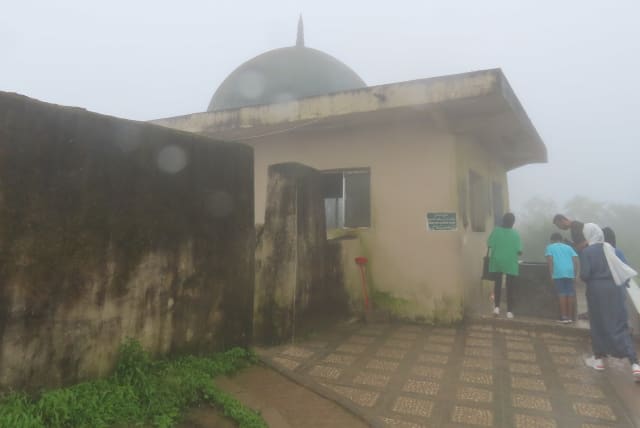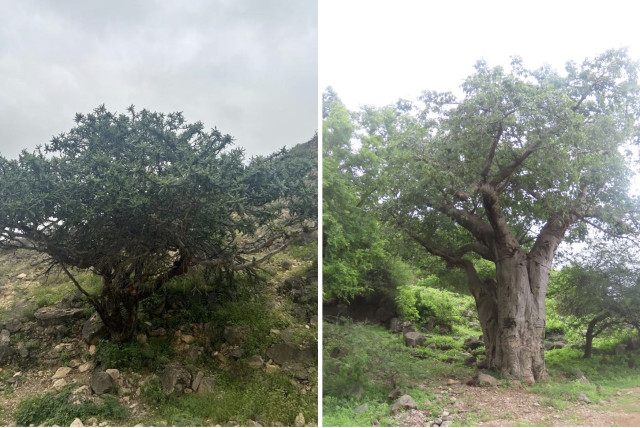Oman’s Khareef Festival: A Monsoon Retreat in the Middle East

Tourists flock to southern Oman for a refreshing escape during the harsh Arabian summers.
As extreme heat pummels the Arabian Peninsula, tourists from across the region have been flocking to the southern Omani city of Salalah for the annual Khareef festival, which celebrates Salalah’s unique climate. While temperatures elsewhere in the region have averaged 104° Fahrenheit (40° Celsius), visitors to Salalah have been able to enjoy a balmy average of just 77° F (25° C).
Khareef, which means “autumn” in Arabic, refers to monsoon season in Oman, which occurs between late June and early September, the height of summer for most other areas. Compared to the potentially devastating monsoon seasons in East Asia, the Khareef season is mild, with pleasantly cool and breezy weather with fog and light rain, leading to an outburst of lush greenery.
Anwar al-Habsi, sales manager of the Salalah Garden Hotel and a native of the Omani capital Muscat, about 500 miles northwest of Salalah, told The Media Line that Salalah hotels burst with visitors during Khareef. Omanis from further north, including from Muscat, tend to head south to “escape the heat in summer,” he said.
Last year, nearly 813,000 tourists visited Salalah during the Khareef season, 6% more than 2021’s 767,000 visitors.
Ahmed Al-Mahri, a local guide for Salalah Glory Tours, told The Media Line that Arab and non-Arab tourists tend to visit Salalah at different times of the year.
Arab season and foreigner season
“We have two major seasons where tourists come. We colloquially refer to them as the Arab season and the foreigner season,” he said. During the Khareef season, most visitors are Arabs or expatriates living in Gulf countries. Tourists from other parts of the world tend to come in December, he said.
According to Oman’s National Center for Statistical Information, 2.9 million tourists visited Oman last year. The majority, 1.9 million, were from the United Arab Emirates, with India, Yemen, and Germany next on the list.
Salalah is located in the Dhofar Governorate in southern Oman, bordering the Arabian Sea. The region can seem more tropical than Middle Eastern, with coconut trees rather than date palms adorning the landscape. However, herds of camels crossing the roads do remind visitors that they are in the Middle East.
In just a small stretch of the Dhofar region, visitors can find mountains, deserts, freshwater lakes and rivers, and coastal beaches. Tourists may also welcome Oman’s low crime rate. However, they will not find alcohol sold freely. Oman has strict laws around alcohol use, and alcohol can be purchased in Salalah only in five-star resorts.
Regional delicacies include camel meat and the sticky confection halwa (also known as halva).
The lush valley of Wadi Darbat is one of Salalah’s most popular tourist attractions. The site features a lake, large ponds, and waterfalls, with vendors offering boat trips and selling wares at seasonal stalls.
The region is also known for its 200 or so baobabs, bizarre-looking trees native to East Africa and Madagascar. Other unique features include a hidden beach, marine geysers, and a gravity hill, a road where the landscape creates an optical illusion that makes cars placed in neutral appear to travel uphill magically.
In addition to its natural scenery, Salalah also features numerous religious sites. Many tombs in Salalah are believed to belong to biblical and Quranic figures, including Job, Imran, and Hud. The tomb of Imran, the father of Mary according to Muslim tradition, is said to be the longest tomb in the world, at about 40 feet. Footprints and hoofprints outside the Prophet Job’s grave are believed to belong to Job and the Prophet Saleh’s camel.
The supposed tomb of Cheraman Perumal, believed to be the first Indian king to convert to Islam, is also a tourist attraction for Indians from the state of Kerala, where he ruled.
Mohammed Irfan, an Indian native who now lives in the UAE, told The Media Line he visited the grave in 2022.
“It is a very important part of history for us Keralites,” he said. “More than that, it helps to better understand historic trade links and how South Asians have been in contact with Arabs for a long time.”
Some Mormon scholars believe that Salalah is the site named in the Book of Mormon as the city Bountiful, where the Prophet Lehi settled before sailing to the Americas with his band of Israelites.
The Land of Frankincense site in Salalah features the remnants of a frankincense trading port active from the eighth to the 16th centuries and is designated a UNESCO world heritage site. Local rumor has it that the frankincense brought to the infant Jesus by the three wise men came from Salalah.
Muslim visitors are also interested in the Sultan Qaboos Grand Mosque in the city center. Completed in 2001, it is Salalah’s largest mosque.
The region features nonreligious historical sites as well, such as the ruins of Sumhuram, a fortified port city that existed from about the fourth century BCE to the fourth century CE. The remains of the legendary lost city of Ubar, also known as the Atlantis of the Sands, are located about 110 miles north of Salalah.
“As more people outside learn about the Khareef and the word spreads, they will start coming to see that this is a very unique place with a lot of sites to offer,” Al-Mahdi said.
With a population of about 450,000, Salalah is Oman’s second most populous city after Muscat. Unlike many other Gulf cities, neither city has massive skyscrapers or futuristic architecture. Western attire is also less common, and tourists are expected to dress modestly. Most Omanis are either Sunni Muslims or Ibadi Muslims, but members of each branch coexist and pray in each other’s mosques.
As well as Arabic, Salalah locals speak the Semitic languages of Mehri and Shehri. The region is also home to Baloch, Zanzibari, and Swahili people who came to Oman from its former colonial outposts.
Oman has been ruled by Arabs since 1749 when Ahmad bin Said al-Busaidi took control of the country from the Persians. The Al-Busaid dynasty has ruled over the country ever since. Oman was a de facto British protectorate for almost a century from the late 19th century. In 1932, Salalah was made Oman’s capital, but in 1970 the capital was moved to Muscat.
Jerusalem Post Store
`; document.getElementById("linkPremium").innerHTML = cont; var divWithLink = document.getElementById("premium-link"); if (divWithLink !== null && divWithLink !== 'undefined') { divWithLink.style.border = "solid 1px #cb0f3e"; divWithLink.style.textAlign = "center"; divWithLink.style.marginBottom = "15px"; divWithLink.style.marginTop = "15px"; divWithLink.style.width = "100%"; divWithLink.style.backgroundColor = "#122952"; divWithLink.style.color = "#ffffff"; divWithLink.style.lineHeight = "1.5"; } } (function (v, i) { });


